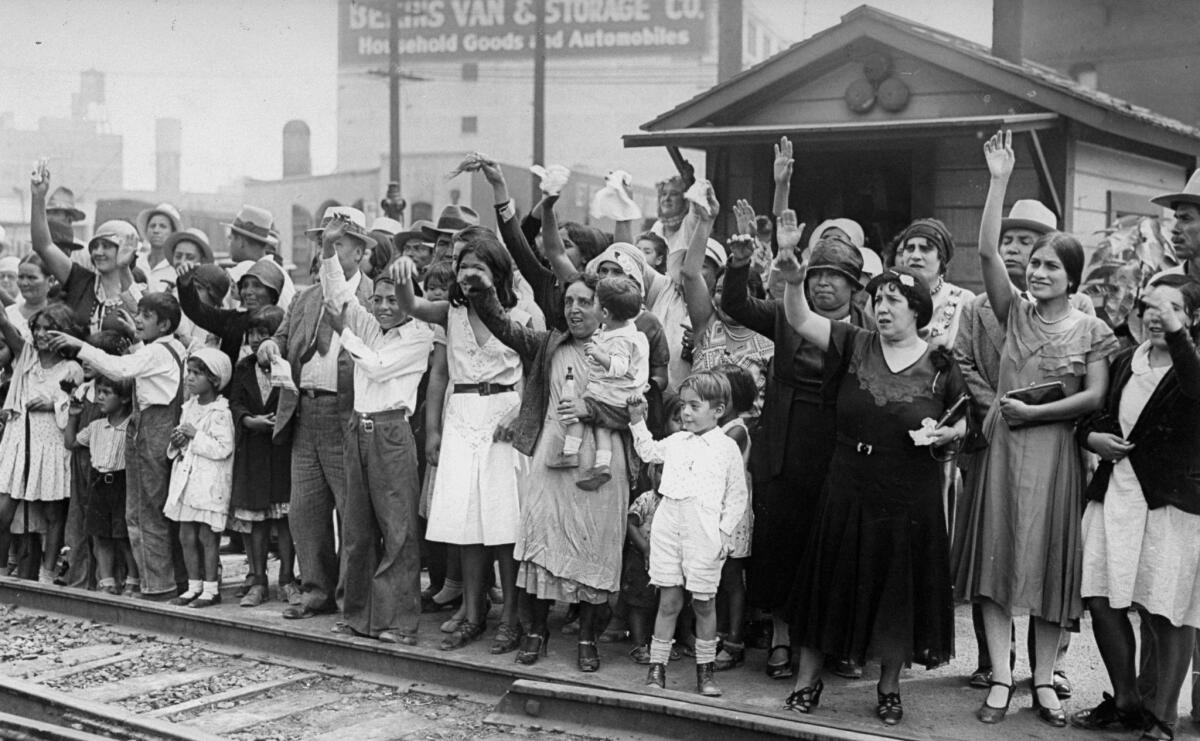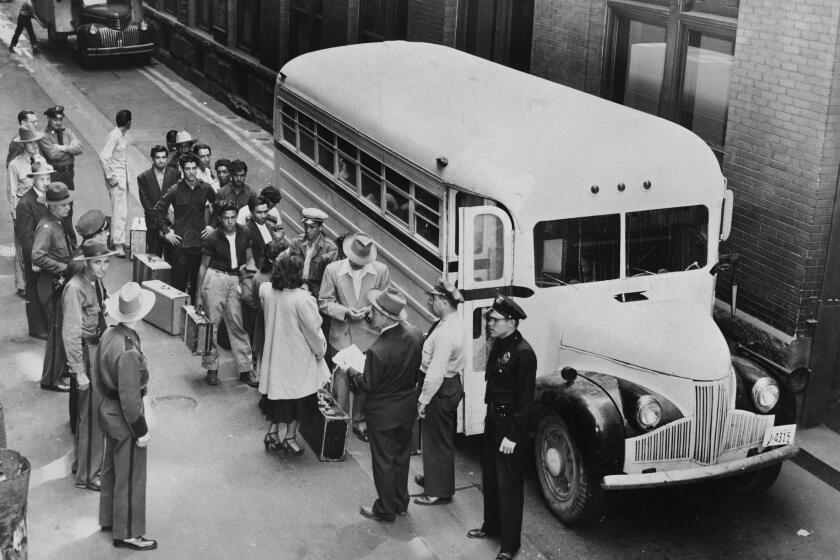Opinion: Trump says he’ll expel a million immigrants. Believe him — it happened before

- Share via
Last month former President Trump promised to eject a million immigrants who are legally in the United States. While some tend to dismiss such threats as merely Trump’s bluster, most of us are unaware that there’s a chilling precedent for this kind of mass expulsion. During the Great Depression, when many falsely blamed Mexican immigrants and Mexican Americans for the economic crisis, as many as a million were forced out of the country, a majority of whom were U.S. citizens. Known as “Repatriados,” they have largely disappeared from popular memory, along with the atrocity of their expulsion.
In the late 1920s, around 1.5 million people of Mexican descent were living in the United States. Many were not immigrants: Their territory had been conquered from Mexico in 1848 and their families were suddenly stuck in a different nation. By the eve of the Depression, alongside thousands of immigrants that came to the U.S. in the years that followed, they and their descendents lived throughout California, the Midwest and the Southwest, mostly working on farms but also as domestic servants or in construction.
California lawmakers are considering a bill to make a statue memorializing the Mexican repatriation of the 1930s, an operation that involved deporting about a million people.
When the economy collapsed in the early 1930s, Mexicans, along with other immigrants, were blamed for taking jobs away from white “Americans.” Severo Márquez, for example, originally from Chihuahua, spent two decades working in the U.S. In the early 1930s he was living with his family in East L.A., working for a contractor who employed a crew of Mexicans to pave roads. Márquez had a Dodge and Ford; his wife was going to night school to learn English. Suddenly his employer fired all the Mexicans. “There wasn’t a lot of work,” Márquez recalled, “so they wanted what little there was to go to citizens.” He couldn’t get a new job, and eventually he and his family fled to Mexico to start over.
When Mexicans and Mexican Americans applied for relief, white social workers told them they weren’t welcome and handed them train or boat tickets to Mexico. When they looked for work, they were told to get out of the country and stop taking jobs from “Americans.” Government authorities launched terrifying raids in Los Angeles, detaining hundreds in public parks. They rode around neighborhoods with loudspeakers telling people to “surrender themselves” and placed radio and newspaper ads announcing that all immigrants were going to be deported. The City of Los Angeles and the State of California passed laws in 1931 making it illegal for any employer who received public funds to hire “aliens,” part of a program developed by President Hoover that encouraged such local mandates.
Trump warns he would kick out hundreds of thousands of immigrants who have entered the country under two Biden administration programs.
In California, many expulsions were driven by white agricultural elites. In the early 1930s, after years of decreasing wages and poor living conditions, Mexican and Filipino farmworkers staged widespread, powerful workstrikes, climaxing in a successful strike of 14,000 cotton pickers in the San Joaquin Valley in 1933. In response, authorities swiftly swept in to deport activists, in what journalist Carey McWilliams called “the rise of farm fascism.”
Nationwide, 82,000 Mexicans were officially deported by the federal government in the 1930s. But most of the Repatriados were not deported, technically. Rather, they were forced to leave through state-sponsored repression. Throughout the early 1930s they headed to Mexico, filling trains from Los Angeles, Arizona and Texas, and traveling in huge caravans from Chicago, St. Louis and elsewhere. In Texas, as hundreds of thousands passed through, some small business owners in the Mexican community fed the migrants and even organized donations of household goods, tools and funds.
The former president’s lies about illegal immigration don’t even make sense. His ideas would make food and housing more expensive.
In these same years another migration, largely of white people, flowed west from Arkansas, Oklahoma, Texas and other parts of the Southwest, filling the jobs that Mexicans and Mexican Americans had vacated in the fields. Some saw them as heroic emblems of Depression-era suffering. Within a few years, the World War II production boom pulled them out of the fields and into good factory jobs. But who, then, would pick the crops? The answer, not surprisingly, was Mexicans. In 1942, the U.S. and Mexican governments set up the bracero program, a hyper-exploitative plan for “guest workers” that included some of the very same people who had been expelled.
In Mexico, most Repatriados returned to their communities of origin and extended families. But many older children refused to leave the U.S., tearing families apart. The youth who did go to Mexico faced culture shock — their new homes sometimes lacked indoor plumbing and electricity, and in many cases they didn’t speak Spanish. While some returned to the U.S. after the war, others couldn’t, because they lacked documentation.
In the 1970s, Chicano historians brought new attention to the Repatriados and conducted dozens of interviews, unearthing generational trauma that had been deeply buried. These efforts helped bring about California’s Apology Act for the 1930s Mexican Repatriation Program, which became official in 2006. The story of the Repatriados is now kept alive in Mexican American history courses and collective memory, reverberating on both sides of the border.
Today, we must take Trump’s threats of mass deportation seriously. We can honor those who lived through the expulsions of the 1930s by pushing back against his dangerous proposal and working to ensure that the atrocities the Repatriados endured don’t happen again.
Dana Frank is a professor of history emerita at UC Santa Cruz and the author, most recently, of “What Can We Learn From the Great Depression? Stories of Ordinary People and Collective Action in Hard Times.”
More to Read
A cure for the common opinion
Get thought-provoking perspectives with our weekly newsletter.
You may occasionally receive promotional content from the Los Angeles Times.













